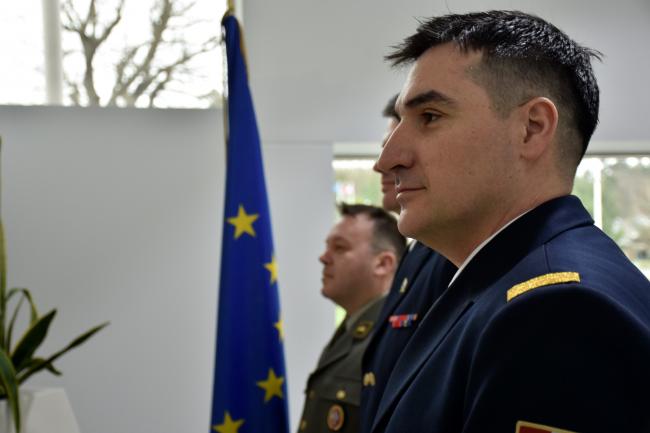EU NAVFOR is about to increase operational activity in the region with the 28th rotation of the Force Headquarters to be embarked on military warships. To mark this, this discussion piece summarises recent activity and gives a focus on EU NAVFOR priorities. At the time of going to press events, an attack in the Southern Red Sea on the Merchant Tanker vessel ABQAIQ served to emphasis the potential threats and the need for all maritime users to maintain vigilance and to adhere to ‘Best Management Practices’.
The European Union launched its first ever Naval Force; Operation ATALANTA under the Common Security and Defence Policy in December 2008. This was in response to the increasing number of piracy attacks off the coast of Somalia. Since then, Op ATALANTA has become a true success story of the European Union’s effort to deter, prevent and repress acts of piracy and armed robbery at sea off the coast of Somalia.
 EUNAVFOR's ESPS Galicia and CTF150's FS Var
EUNAVFOR's ESPS Galicia and CTF150's FS Var
By working with international partners including Combined Maritime Forces, independent deployers such as China, India and the Republic of Korea as well as States throughout the region including Djibouti and the Seychelles, EU NAVFOR has built up a robust network of counter-piracy effort and remains pivotal to its continued suppression across the area of operations. This focus on cooperating closely as part of a broader maritime security architecture is vital at this time to encourage the comprehensive approach of finding solutions to the maritime problems in the region.
Protecting Vulnerable Shipping: “A daily operation”
One key mandate requirement for EU NAVFOR is the protection of World Food Programme (WFP) and vulnerable shipping transiting the major shipping route along the Somalian coastline. At the date of editing, Op ATALANTA has protected the delivery of over 1.75Mt of aid to the people of Somalia and this number will continue to increase so long as needed.
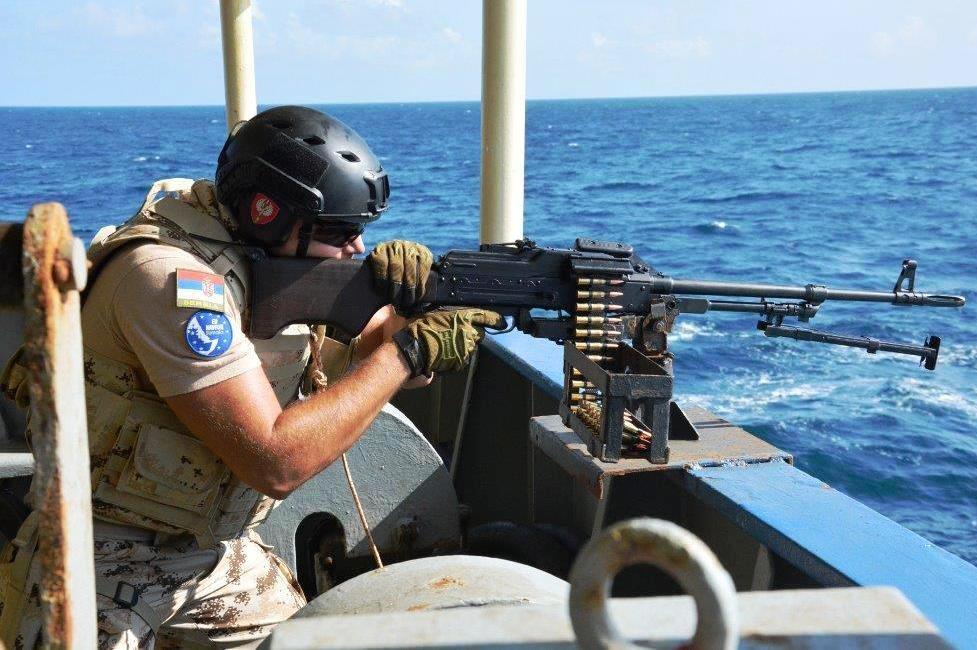 Serbian troops embarked on WFP vessels in 2017
Serbian troops embarked on WFP vessels in 2017
EU NAVFOR provides warship escorts coordinated by the Maritime Security Centre – Horn of Africa (MSCHOA), based at the Operational HQ in London, these escorts include those under direct command but can also include independent deployed ships from China, India and Russia. Most recently the Chinese Warship Yancheng escorted the Merchant Vessel Selin-M through the Gulf of Aden to Mombasa. The success rate for this task is 100%.
Deterring Piracy: “A constant threat”
On 18th November 2017 EU NAVFOR Flagship, Italian Warship (ITS) Virginio Fasan was patrolling a region of the Western Somali basin when reports of an attack to the container ship MV Ever Dynamic were received by the MSCHOA and the UKMTO based in Dubai. During the incident, a number of rocket-propelled grenades were fired towards the container ship. However, adherence to Best Management Practices Version 4 (BMP4), the presence of an armed security team, and good seamanship avoided any damage to the ship, and all the crew remained safe. This action clearly ensured the suspected pirates failed to take the ship.
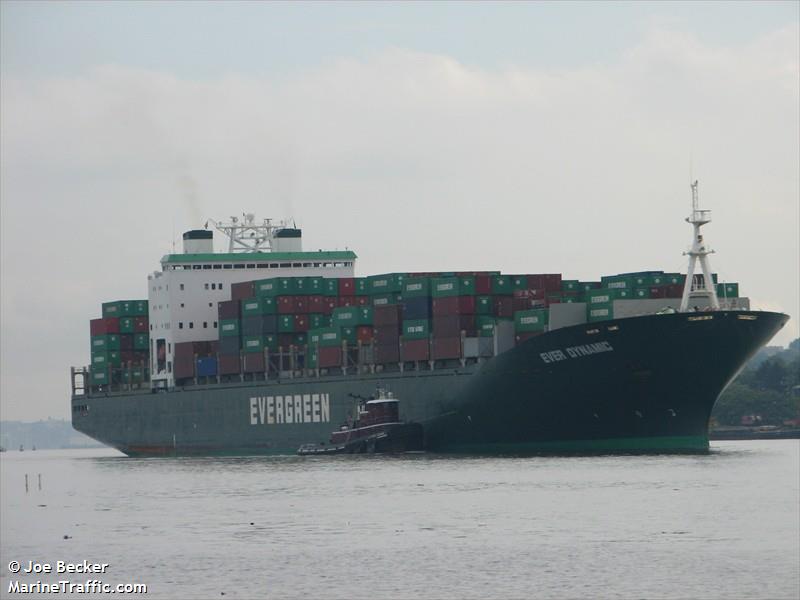 MV Ever Dynamic, Attacked in the Western Indian Ocean in November 2017
MV Ever Dynamic, Attacked in the Western Indian Ocean in November 2017
MSCHOA then alerted International shipping that there was a suspected active pirate group operating in the area and to take appropriate precautions and increase vigilance. The following day a second attack was reported by the fishing vessel Galerna III which was operating out of the port of Victoria in the Seychelles and not too far from the first incident. The details of the two attacks and information given by the masters of the two vessels were shared and analysed with our military partners such as CMF and it was clear that the two incidents could be related and perpetrated by the same group. This information was then passed to EU NAVFOR’s Force Commander, Rear Admiral Fabio Gregori from the Italian Navy, who was embarked on the ITS Fasan.
Using all EU NAVFOR assets, he was able to Find the suspected pirates (using EU NAVFOR Maritime Patrol Aircraft based in Djibouti), Fix them using the helicopter from the flagship and then Finish with an arrest by Italian marines on fast boats. The six suspected pirates were detained and the skiff/whaler s and equipment seized under United Nations Security Council resolution 2383. The Admiral then set a course for the Seychelles.
With the suspected pirates apprehended, EU NAVFOR’s MSCHOA and Media Team released statements to international media and maritime trade organisations to inform them that the six suspected pirates would be transferred to the Seychelles to be investigated by the Seychellois authorities, where if convicted, face up to 30 years in Jail.
Deterring Piracy: “Judicial process development and the Prosecution Pathway”
EU NAVFOR has been instrumental in developing international agreements allowing regional prosecution of suspected pirates. So far Kenya, The Seychelles and Mauritius have the ability to receive suspected pirates transferred by EU NAVFOR and prosecute them under international law. This judicial development is key to the prosecution of suspected pirates and allows them to be remanded in custody, charged, tried, sentenced and finally detained in accordance with EU human rights standards.
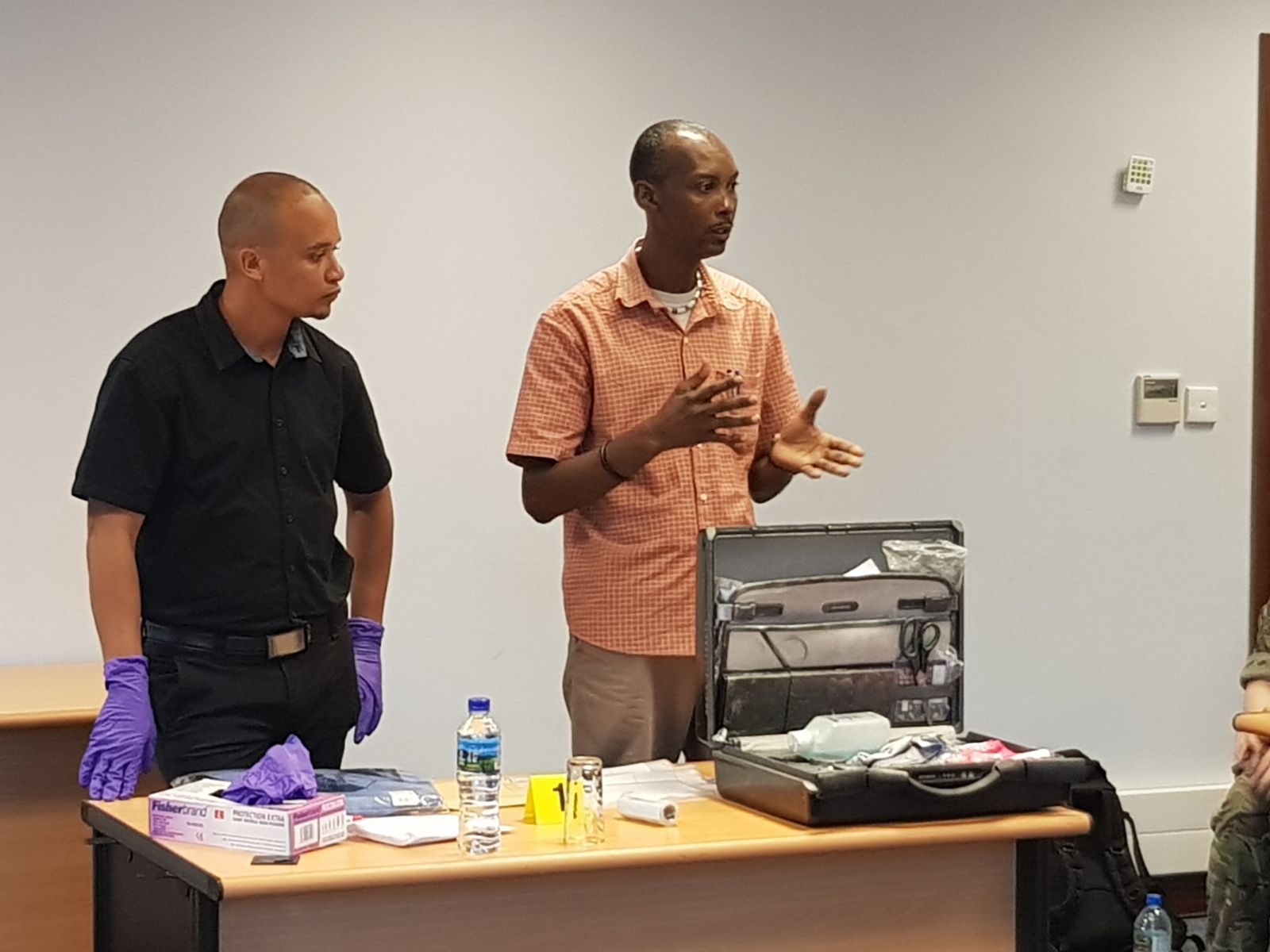 Justice Pathway Lecture in March 2018
Justice Pathway Lecture in March 2018
In addition to helping to establish international agreements on the prosecution of pirates, Op ATALANTA personnel have held several seminars across the region to help Indian Ocean countries to develop their judicial skills. Over three days in March 2018, teams from EU NAVFOR and the United Nations Office on Drugs and Crime (UNODC) deployed to the Seychelles to conduct training with law enforcement agencies hosted at the REFLECS3 (Regional Fusion and Law Enforcement Centre for Safety and Security at Sea).
The programme was designed to ensure the continued improvement and development of all areas within the justice system. Building on the last exercise, in May 2017, the programme focused on media handling, evidence collection and crime scene management, and incorporated a discussion about the transfer of suspected pirates that took place between EU NAVFOR and the Seychelles in Nov 2017. The international attendees engaged in classroom-based learning and discussions followed by an exercise on a dhow with a simulated but realistic crime scene.
Barry Faure, the Seychellois Secretary of State for Foreign Affairs, attended the closing ceremony. He discussed the “very positive approach of all concerned,” and outlined the importance of the Seychelles becoming a focal point for dealing with maritime crime.
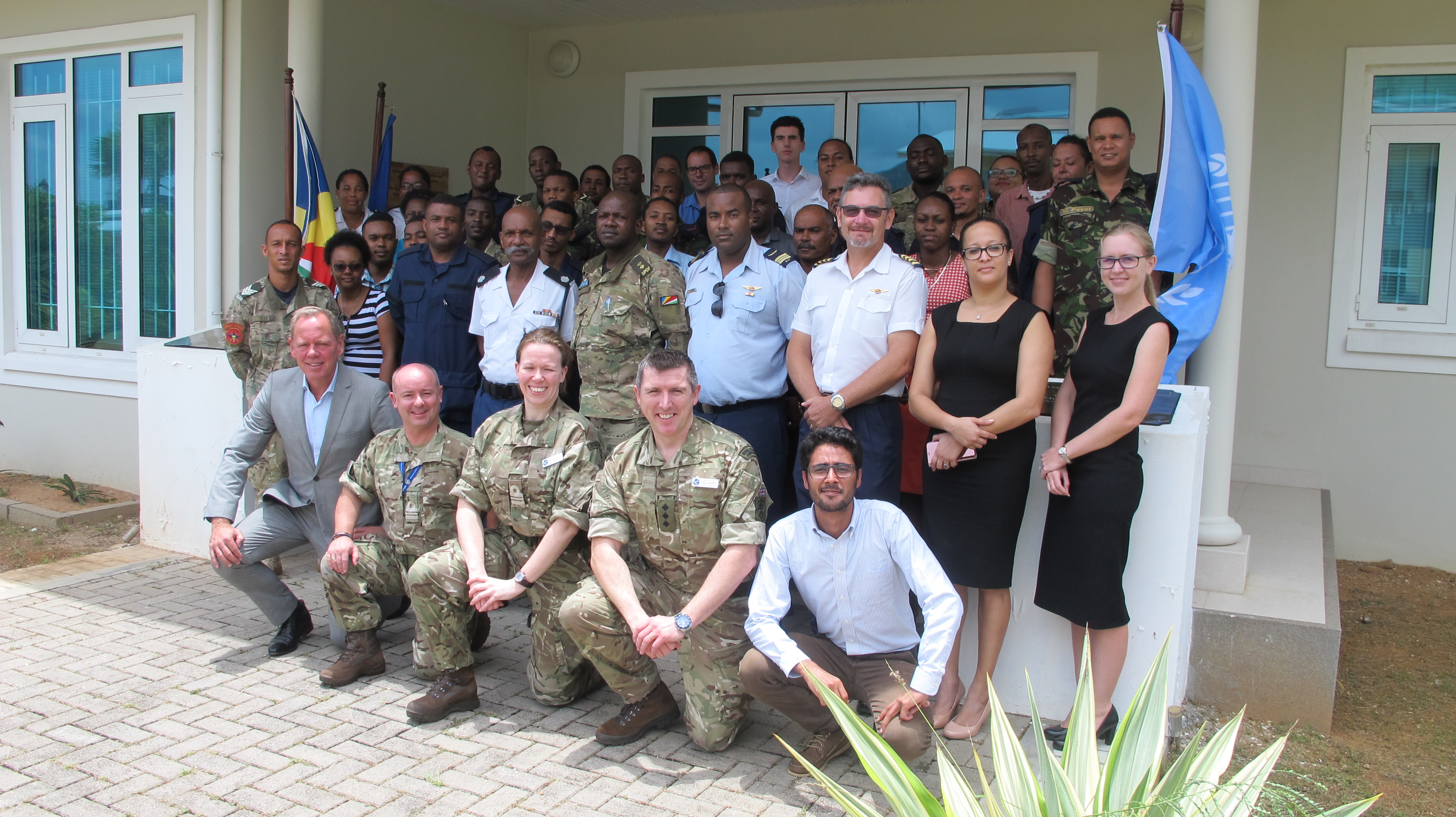 Participants at the recent Justice Pathway programme in the Seychelles in March 2018
Participants at the recent Justice Pathway programme in the Seychelles in March 2018
Seychellois authorities have been working alongside EU NAVFOR and the UNODC as part of the legal finish for counter-piracy operations. Those present on Prosecution Pathway included Seychelles Maritime Police Unit, Seychelles Coast Guard, Scientific Support and Crime Record Bureau, Seychelles Police Force and CID, lawyers from the Attorney General’s Office, State Counsel and the Seychelles Peoples Defence Force.
Shared Awareness De-Confliction Conference (SHADE): “Cooperation and coordination”
Op ATALANTA operates to a very high military standard that has become renowned throughout the region as a premier counter-piracy operation. However, it continues to endeavour to bring together all the active players in this vital maritime trade route in order to ensure Somali based piracy remains repressed. To do this Op ATALANTA jointly chairs the bi-annual SHADE conference with CMF. At the 41st shade conference over 120 stakeholders, including Independent Naval Counter-piracy representatives from China, India, Japan, Korea and Russia, presented their latest tactical counter-piracy efforts to ensure the safety of maritime trade through this essential trade route. Major maritime stakeholders from the shipping industry put forward their concerns over the instability in the region and the real threat to the safe transfer of commence.
During discussions, it was recognised that EU NAVFOR and its Maritime Security Centre (MSCHOA.org) play a pivotal role in optimising coordination and de-conflicting operations between all naval forces deployed off the Horn of Africa fighting the piracy threats.
Director of MSCHOA, Simon Church has said at a SHADE conference: “The Shipping Industry is a key partner in SHADE and it has been great to see representatives from OCIMF, Intertanko, ICS and BIMCO here” he added: “for the first time at SHADE we saw a panel of Company Security Officers covering the Tanker, LNG, Dry-bulk and Container sectors take part in an interactive forum which has helped deepen the understanding of the pressures in risk management that CSO’s carry.”
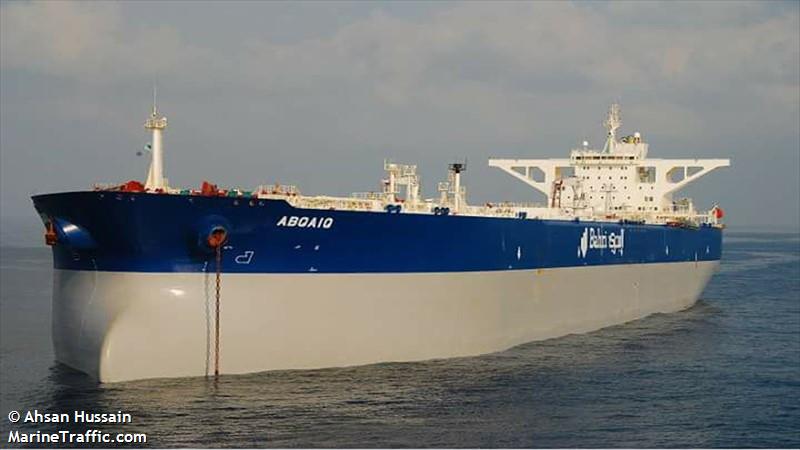 MT ABQAIQ, attacked in April 2018
MT ABQAIQ, attacked in April 2018
Given the diversification of emerging threats from Yemen and the establishment of the new Maritime Security Transit Corridor (MSTC) linking the Red Sea, through the Bab El Mandeb Strait and onto the IRTC in the Gulf of Aden, there was an opportunity for both Military Forces and Shipping Industry Representatives to explore how to address the complex and fluid threat dynamic that now exists through this major maritime choke point.
Furthermore the recent attacks by a suspected Pirate Action Group against the 55,000t Container Ship MV Ever Dynamic and on the Fishing Vessel Gallerna III in the same vicinity 300 miles east of Mogadishu demonstrated the existing capabilities for long range pirate activity. This targeted approach to shipping provides evidence of the continued need for Naval Force presence across the both the Gulf of Aden and the Somali Basin. Importantly, as well as the continuing application of BMP by ships in the High Risk Area and time critical coordination between Naval Assets, MSCHOA and UKMTO. EU NAVFOR remains a catalyst for closer cooperation, coordination and partnership.
The European Union launched its first ever Naval Force; Operation ATALANTA under the Common Security and Defence Policy in December 2008. This was in response to the increasing number of piracy attacks off the coast of Somalia. Since then, Op ATALANTA has become a true success story of the European Union’s effort to deter, prevent and repress acts of piracy and armed robbery at sea off the coast of Somalia.
 EUNAVFOR's ESPS Galicia and CTF150's FS Var
EUNAVFOR's ESPS Galicia and CTF150's FS VarBy working with international partners including Combined Maritime Forces, independent deployers such as China, India and the Republic of Korea as well as States throughout the region including Djibouti and the Seychelles, EU NAVFOR has built up a robust network of counter-piracy effort and remains pivotal to its continued suppression across the area of operations. This focus on cooperating closely as part of a broader maritime security architecture is vital at this time to encourage the comprehensive approach of finding solutions to the maritime problems in the region.
Protecting Vulnerable Shipping: “A daily operation”
One key mandate requirement for EU NAVFOR is the protection of World Food Programme (WFP) and vulnerable shipping transiting the major shipping route along the Somalian coastline. At the date of editing, Op ATALANTA has protected the delivery of over 1.75Mt of aid to the people of Somalia and this number will continue to increase so long as needed.
 Serbian troops embarked on WFP vessels in 2017
Serbian troops embarked on WFP vessels in 2017EU NAVFOR provides warship escorts coordinated by the Maritime Security Centre – Horn of Africa (MSCHOA), based at the Operational HQ in London, these escorts include those under direct command but can also include independent deployed ships from China, India and Russia. Most recently the Chinese Warship Yancheng escorted the Merchant Vessel Selin-M through the Gulf of Aden to Mombasa. The success rate for this task is 100%.
Deterring Piracy: “A constant threat”
On 18th November 2017 EU NAVFOR Flagship, Italian Warship (ITS) Virginio Fasan was patrolling a region of the Western Somali basin when reports of an attack to the container ship MV Ever Dynamic were received by the MSCHOA and the UKMTO based in Dubai. During the incident, a number of rocket-propelled grenades were fired towards the container ship. However, adherence to Best Management Practices Version 4 (BMP4), the presence of an armed security team, and good seamanship avoided any damage to the ship, and all the crew remained safe. This action clearly ensured the suspected pirates failed to take the ship.
 MV Ever Dynamic, Attacked in the Western Indian Ocean in November 2017
MV Ever Dynamic, Attacked in the Western Indian Ocean in November 2017MSCHOA then alerted International shipping that there was a suspected active pirate group operating in the area and to take appropriate precautions and increase vigilance. The following day a second attack was reported by the fishing vessel Galerna III which was operating out of the port of Victoria in the Seychelles and not too far from the first incident. The details of the two attacks and information given by the masters of the two vessels were shared and analysed with our military partners such as CMF and it was clear that the two incidents could be related and perpetrated by the same group. This information was then passed to EU NAVFOR’s Force Commander, Rear Admiral Fabio Gregori from the Italian Navy, who was embarked on the ITS Fasan.
Using all EU NAVFOR assets, he was able to Find the suspected pirates (using EU NAVFOR Maritime Patrol Aircraft based in Djibouti), Fix them using the helicopter from the flagship and then Finish with an arrest by Italian marines on fast boats. The six suspected pirates were detained and the skiff/whaler s and equipment seized under United Nations Security Council resolution 2383. The Admiral then set a course for the Seychelles.
With the suspected pirates apprehended, EU NAVFOR’s MSCHOA and Media Team released statements to international media and maritime trade organisations to inform them that the six suspected pirates would be transferred to the Seychelles to be investigated by the Seychellois authorities, where if convicted, face up to 30 years in Jail.
Deterring Piracy: “Judicial process development and the Prosecution Pathway”
EU NAVFOR has been instrumental in developing international agreements allowing regional prosecution of suspected pirates. So far Kenya, The Seychelles and Mauritius have the ability to receive suspected pirates transferred by EU NAVFOR and prosecute them under international law. This judicial development is key to the prosecution of suspected pirates and allows them to be remanded in custody, charged, tried, sentenced and finally detained in accordance with EU human rights standards.
 Justice Pathway Lecture in March 2018
Justice Pathway Lecture in March 2018In addition to helping to establish international agreements on the prosecution of pirates, Op ATALANTA personnel have held several seminars across the region to help Indian Ocean countries to develop their judicial skills. Over three days in March 2018, teams from EU NAVFOR and the United Nations Office on Drugs and Crime (UNODC) deployed to the Seychelles to conduct training with law enforcement agencies hosted at the REFLECS3 (Regional Fusion and Law Enforcement Centre for Safety and Security at Sea).
The programme was designed to ensure the continued improvement and development of all areas within the justice system. Building on the last exercise, in May 2017, the programme focused on media handling, evidence collection and crime scene management, and incorporated a discussion about the transfer of suspected pirates that took place between EU NAVFOR and the Seychelles in Nov 2017. The international attendees engaged in classroom-based learning and discussions followed by an exercise on a dhow with a simulated but realistic crime scene.
Barry Faure, the Seychellois Secretary of State for Foreign Affairs, attended the closing ceremony. He discussed the “very positive approach of all concerned,” and outlined the importance of the Seychelles becoming a focal point for dealing with maritime crime.
 Participants at the recent Justice Pathway programme in the Seychelles in March 2018
Participants at the recent Justice Pathway programme in the Seychelles in March 2018Seychellois authorities have been working alongside EU NAVFOR and the UNODC as part of the legal finish for counter-piracy operations. Those present on Prosecution Pathway included Seychelles Maritime Police Unit, Seychelles Coast Guard, Scientific Support and Crime Record Bureau, Seychelles Police Force and CID, lawyers from the Attorney General’s Office, State Counsel and the Seychelles Peoples Defence Force.
Shared Awareness De-Confliction Conference (SHADE): “Cooperation and coordination”
Op ATALANTA operates to a very high military standard that has become renowned throughout the region as a premier counter-piracy operation. However, it continues to endeavour to bring together all the active players in this vital maritime trade route in order to ensure Somali based piracy remains repressed. To do this Op ATALANTA jointly chairs the bi-annual SHADE conference with CMF. At the 41st shade conference over 120 stakeholders, including Independent Naval Counter-piracy representatives from China, India, Japan, Korea and Russia, presented their latest tactical counter-piracy efforts to ensure the safety of maritime trade through this essential trade route. Major maritime stakeholders from the shipping industry put forward their concerns over the instability in the region and the real threat to the safe transfer of commence.
During discussions, it was recognised that EU NAVFOR and its Maritime Security Centre (MSCHOA.org) play a pivotal role in optimising coordination and de-conflicting operations between all naval forces deployed off the Horn of Africa fighting the piracy threats.
Director of MSCHOA, Simon Church has said at a SHADE conference: “The Shipping Industry is a key partner in SHADE and it has been great to see representatives from OCIMF, Intertanko, ICS and BIMCO here” he added: “for the first time at SHADE we saw a panel of Company Security Officers covering the Tanker, LNG, Dry-bulk and Container sectors take part in an interactive forum which has helped deepen the understanding of the pressures in risk management that CSO’s carry.”
 MT ABQAIQ, attacked in April 2018
MT ABQAIQ, attacked in April 2018Given the diversification of emerging threats from Yemen and the establishment of the new Maritime Security Transit Corridor (MSTC) linking the Red Sea, through the Bab El Mandeb Strait and onto the IRTC in the Gulf of Aden, there was an opportunity for both Military Forces and Shipping Industry Representatives to explore how to address the complex and fluid threat dynamic that now exists through this major maritime choke point.
Furthermore the recent attacks by a suspected Pirate Action Group against the 55,000t Container Ship MV Ever Dynamic and on the Fishing Vessel Gallerna III in the same vicinity 300 miles east of Mogadishu demonstrated the existing capabilities for long range pirate activity. This targeted approach to shipping provides evidence of the continued need for Naval Force presence across the both the Gulf of Aden and the Somali Basin. Importantly, as well as the continuing application of BMP by ships in the High Risk Area and time critical coordination between Naval Assets, MSCHOA and UKMTO. EU NAVFOR remains a catalyst for closer cooperation, coordination and partnership.
